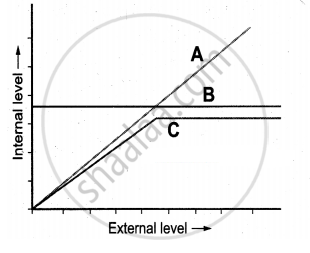Advertisements
Advertisements
प्रश्न
What are the ways by which organisms respond to abiotic factors?
उत्तर
The ways by which organism respond to abiotic stress are Regulate, Conform, Migrate and Suspends, etc.
संबंधित प्रश्न
Give an example of an organism that enters 'diapause' and why.
Explain why very small animals are rarely found in polar region.
In certain seasons we sweat profusely while in some other season we shiver. Explain.
State how the constant internal environment is beneficial to organisms.
Explain any two alternatives by which organisms can overcome stressful external conditions.
Distinguish between Hibernation and Aestivation
The following question(s)/statement(s) has four suggested answers. Choose the correct option in the following case.
The curve showing the amount of light absorbed at each wavelength is : ____________.
Answer the following question.
‘‘Organisms may be conformers or regulators.’’ Explain this statement and give one example of each.
Answer the following question.
Why are there more conformers than regulators in the animal world?
The figure given below is a diagrammatic representation of response of organisms to abiotic factors. What do A, B and C represent respectively.

| S. No. | A | B | C |
| a. | Conformer | Regulator | Partial Regulator |
| b. | Regulator | Partial Regulator | Conformer |
| c. | Partial Regulator | Regulator | Conformer |
| d. | Regulator | Conformer | Partial Regulator |
Some organisms are able to maintain homeostasis by physical means ________.
Match List - I with List - II.
| List I | List II | ||
| (a) | Allen's Rule | (i) | Kangaroo rat |
| (b) | Physiological adaptation |
(ii) | Desert lizard |
| (c) | Behavioural adaptation |
(iii) | Marine fish at depth |
| (d) | Biochemical adaptation |
(iv) | Polar seal |
Choose the correct answer from the options given below.
Assertion (A): A person goes to high altitude and experiences ‘altitude sickness’ with symptoms like breathing difficulty and heart palpitations.
Reason (R): Due to low atmospheric pressure at high altitudes, the body does not get sufficient oxygen.
In the light of the above statements, choose the correct answer from the options given below.
Assertion(A): A person goes to high altitude and experiences ‘altitude sickness’ with symptoms like breathing difficulty and heart palpitations.
Reason(R): Due to low atmospheric pressure at high altitudes, the body does not get sufficient oxygen. In light of the above statements, choose the correct answer from the options given below.
Salt concentration (Salinity) of the sea measured in parts per thousand is ______.
What will happen to a well-growing herbaceous plant in the forest if it is transplanted outside the forest in a park?
What is diapause and its significance?
Why are coral reefs not found in the regions from west Bengal to Andhra Pradesh but are found in Tamil Nadu and on the east coast of India?
